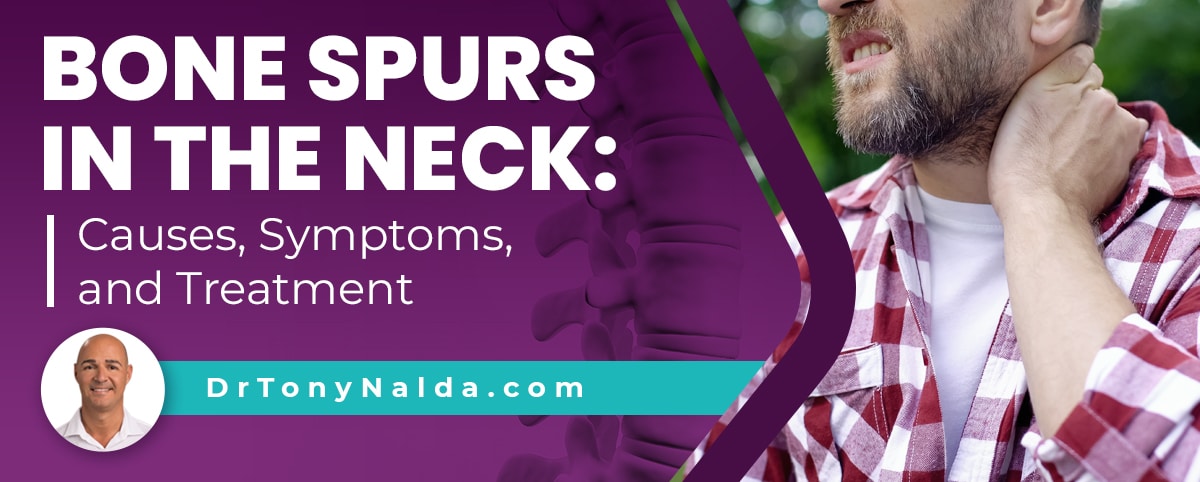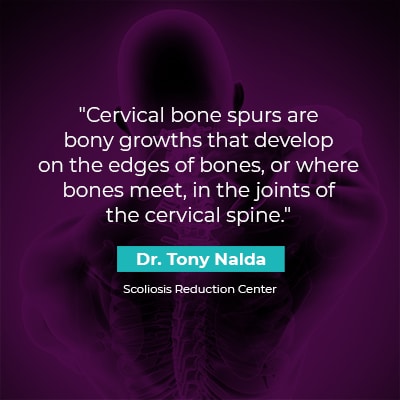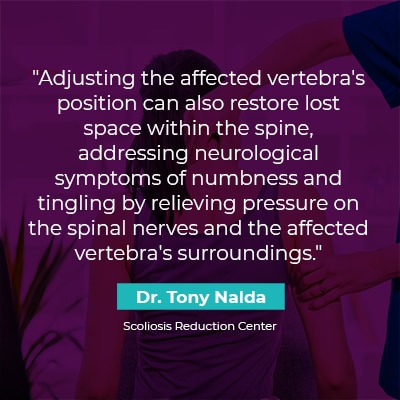Bone Spurs in the Neck: Causes, Symptoms, and Treatment

There are many parts and structures that work together to facilitate spinal flexibility, strength, and function. When a vertebra grows a bone spur, this means there is a bony projection where there shouldn't be, meaning the area and its surroundings are going to be affected by the loss of space and potential nerve compression.
Bone spurs in the neck refer to bony growths that form on bone edges, or where bones meet: in the joints of the cervical spine. These excessive bone growths can cause a number of problems related to a loss of space within the spine and nerve compression.
Before getting to the specifics of bone spurs in the neck, let's first talk about the different spinal sections.
Table of Contents
The Spine's Main Sections
The spine has three main sections, and the health of each is dependent on the health of the others: cervical spine (neck), thoracic spine (middle/upper back), and the lumbar spine (lower back).
So cervical bone spurs form in the neck, and the neck is important for several reasons; it contains the first seven vertebrae of the spine (C1 - C7), connects the brain to the rest of the body, and has to support the weight of neck and head.
The spine consists of vertebrae stacked on top of one another in a straight and neutral alignment, and if the spine is aligned, this means its natural and healthy curves are in place, and natural spinal curves make it stronger, more flexible, and better able to handle stress incurred during activity.
Adjacent vertebrae are separated by an intervertebral disc, and these discs facilitate flexible movement, provide cushioning to prevent friction, give the spine structure (adjacent vertebrae attach to the disc in between), and act as the spine's shock absorber.
When the spine starts to naturally degenerate over time, it's most often the discs that are the first spinal structures to feel the effects (degenerative disc disease).
The vertebrae form a column through which the spinal cord passes, and the spinal cord contains a bundle of nerves that works in tandem with the brain to form the central nervous system (CNS).
When there is excess bone in an area of the spine, it can compress (uneven pressure) the nerves in the area and its surrounding tissues and ligaments, and this can cause a number of issues.
Before we get to the symptoms of cervical bone spurs, let's start with defining the condition.
What are Cervical Bone Spurs?
 Cervical bone spurs are bony growths that develop on the edges of bones, or where bones meet, in the joints of the cervical spine.
Cervical bone spurs are bony growths that develop on the edges of bones, or where bones meet, in the joints of the cervical spine.
Bones are living tissue that constantly changes over time through a process known as remodeling and involves the growth of new bone cells replacing older/damaged bone cells.
Bone spurs are also called osteophytes, and they can develop on any of the body's bones/joints
When bone spurs develop in the spine, this means that they are taking up space used by other spinal structures/parts, including the nerves.
The spinal cord, consisting of 31 pairs of spinal nerves, passes through the vertebral column, so if there is excess bone in an area, it can expose the nerves within to uneven pressure, and this can cause a number of symptoms.
So what are some common symptoms of cervical bone spurs?
Symptoms of Cervical bone Spurs
Developing cervical osteophytes can be part of the natural aging process that involves spinal degeneration, and some cases won't involve noticeable symptoms, while others can cause:
- Neck pain
- Tingling sensations
- Numbness
- Weakness in the area
- Radicular pain in the neck, shoulder, arm and/or hand
- Issues with bowel or bladder control (a rare complication associated with severe cases)
Every section of the spine has important roles to play in maintaining spinal health, and the cervical spine supports the weight of the neck and head, and this makes it particularly vulnerable to deterioration and poor posture.
The cervical spine also facilitates the neck's ability to engage in a number of flexible movements, such as turning the head from side to side and up and down.
Spinal conditions that develop in the cervical spine can make it difficult to move the neck (reduced range of motion) and can also cause pain during movement.
Now that we've defined the condition and explored some of its common symptoms, let's move on to some common causes of cervical osteophytes.
What Causes Cervical Osteophytes?
Remember, bones are living tissues, always renewing and changing.
If the tissues surrounding a vertebra in the cervical spine become damaged or inflamed, the area's nearby bone growth can be affected.
Osteophytes often form where new bone cells are deposited in atypical locations, such as where bones meet, in the joints, or on the edges of bones.
In most cases of neck spurs, they form where ligaments and tendons surrounding cervical vertebrae are inflamed or damaged, and this can be caused by normal wear and tear on the spine that occurs over time.
The most common cause of neck spurs is cervical osteoarthritis: the most common type of arthritis.
Osteoarthritis develops because the cartilage that protects and cushions bone edges erodes over time; the condition can develop in any of the body's joints but is commonly found in the knees, hands, hips, and spine.
When the neck's joints start to deteriorate, this also affects the disc spaces that act as modified joints, known as the spine's facet joints, and uncovertebral joints in the C3 to C7 vertebral bodies.
Osteoarthritis in the neck is also referred to as cervical spondylosis and cervical osteoarthritis and is most common in adults over the age of 50 who are experiencing natural age-related spinal degeneration.
In addition to spinal deterioration that naturally occurs over time, certain lifestyle factors can also increase the severity and rate of spinal deterioration: carrying excess weight, low activity levels, chronic poor posture (tech neck), smoking and excessive alcohol consumption.
Now that we've defined the condition, discussed some common symptoms and causes, let's address how bone spurs in the neck are diagnosed and treated.
Diagnosing and Treating Cervical Osteophytes
As mentioned when discussing cervical osteophyte symptoms, not all cause noticeable pain and issues, which is why it's not uncommon that a diagnosis of cervical bone spurs is reached by accident.
When it comes to diagnosing bone spurs, they are visible in magnetic resonance imaging and X-ray images, and it's not uncommon for patients having X-rays done for unrelated reasons, and the bone spurs are detected and a diagnosis is reached.
So once a diagnosis is given, what are the treatment options?
Here at the Scoliosis Reduction Center, I have years of experience treating a wide range of spinal conditions.
When it comes to treating cervical osteophytes, the underlying cause is what shapes the design and customization of effective treatment plans.
Rest and limiting strenuous movements and activities can help, as can modifying lifestyle factors that are problematic.
When it comes to relieving symptoms caused by issues within the cervical spine, developing ways to improve posture can be particularly helpful because, again, the cervical spine has to support the weight of the head.
Alternating hot/cold therapy can help with relaxing sore muscles and reducing neck pain and inflammation.
When prescribed by a specialist, there are a series of physical therapy exercises that can work towards increasing the neck's flexibility, strengthening it, and maintaining the cervical spine's range of motion.
When it comes to pain medications for pain management, these only help with short-term pain relief, but do nothing for long-term sustainable treatment results because they are only addressing a symptom, not its underlying cause.
There are also a variety of chiropractic techniques, including manual adjustments, that can work towards adjusting the cervical vertebrae to reduce pain and improve range of motion and flexibility.
 Adjusting the affected vertebra's position can also restore lost space within the spine, addressing neurological symptoms of numbness and tingling by relieving pressure on the spinal nerves and the affected vertebra's surroundings.
Adjusting the affected vertebra's position can also restore lost space within the spine, addressing neurological symptoms of numbness and tingling by relieving pressure on the spinal nerves and the affected vertebra's surroundings.
Conclusion
Cervical bone spurs are bony projections that grow on the edges of bones or where bones meet, in the joints of the cervical spine.
There are different severity levels, with some cervical bone spurs causing no symptoms, and others causing common symptoms like neck pain, radicular pain, nerve root pain, muscle weakness, and neurological symptoms.
In rare cases, and/or when very severe, cervical bone spurs can cause issues with bowel or bladder control, and risk factors are aging as natural spinal degeneration (intervertebral discs degenerating) can cause bone spurs to develop and arthritis.
When the protective cartilage that surrounds bones degrades over time, this can affect the smooth gliding motion that joints want to have during activity, and instead, friction and uneven wear and tear on the spine can affect spinal health and function; this can lead to the development of osteoarthritis in the cervical spine.
If the tissues that surround a cervical vertebra become inflamed and/or its surrounding ligaments and tendons, this can also cause the development of osteophytes in the area.
While there are surgical methods to remove bone spurs, here at the Center, I provide conservative treatments (nonsurgical treatments) that can help patients avoid the risks associated with spinal surgery.
Through a combination of condition-specific chiropractic care, a variety of therapies, and physical therapy, I can work towards increasing the cervical spine's flexibility, range of motion, increasing space with the spine so pressure on surrounding nerves is reduced, postural correction, and muscle strengthening.
Dr. Tony Nalda
DOCTOR OF CHIROPRACTIC
After receiving an undergraduate degree in psychology and his Doctorate of Chiropractic from Life University, Dr. Nalda settled in Celebration, Florida and proceeded to build one of Central Florida’s most successful chiropractic clinics.
His experience with patients suffering from scoliosis, and the confusion and frustration they faced, led him to seek a specialty in scoliosis care. In 2006 he completed his Intensive Care Certification from CLEAR Institute, a leading scoliosis educational and certification center.
About Dr. Tony Nalda
 Ready to explore scoliosis treatment? Contact Us Now
Ready to explore scoliosis treatment? Contact Us Now





